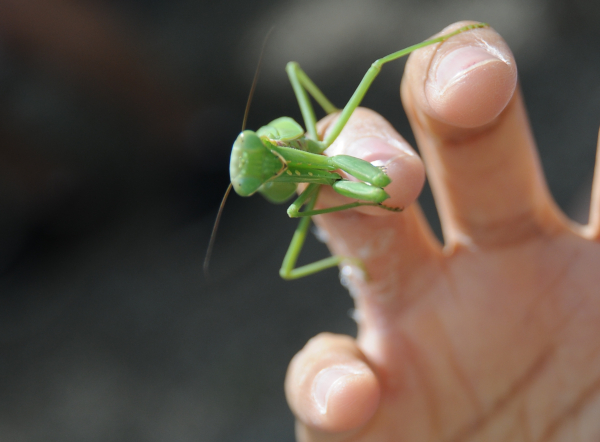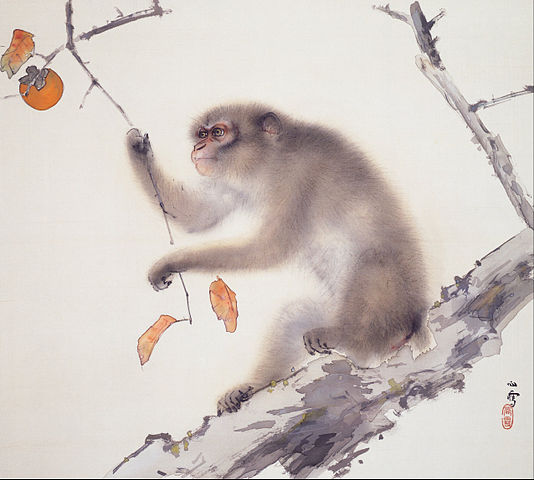I went to a shrine this weekend where somebody picked up this lovely member of Japanese wildlife. He held it on his hand for quite a while before and after this shot. Fascinating – especially how cool many Japanese are about insects.
Category: gardens
Umenomiya Taisha
Umenomiya Taisha is a rather small shrine with a very large garden tucked away in a residential area in Arashiyama. It was founded about 1300 years ago by Agata Inukai no Michiyo (or Tachibana Michiyo) as a shrine for her ancestors, in a little place in the rural parts of Kyoto prefecture. With the rise of the Tachibana family into imperial ranks, the shrine was moved twice before it was relocated to Kyoto around the year 800 to the place where it still stands today.
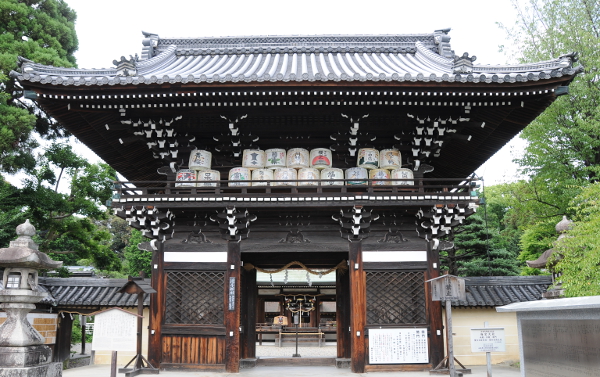 Umenomiya Taisha enshrines the mountain god Oyamazumi-no-kami and his daughter Konohana-no-sakuyahime, the goddess of life. Legend says, that Oyamazumi-no-kami was so pleased when his daughter gave birth to his first grandson, that he invented sake to celebrate the occasion. Furthermore, it is said that her delivery took place one day after her marriage, and it was a quick and easy one. For these reasons, the shrine is still popular with sake brewers and couples hoping for children.
Umenomiya Taisha enshrines the mountain god Oyamazumi-no-kami and his daughter Konohana-no-sakuyahime, the goddess of life. Legend says, that Oyamazumi-no-kami was so pleased when his daughter gave birth to his first grandson, that he invented sake to celebrate the occasion. Furthermore, it is said that her delivery took place one day after her marriage, and it was a quick and easy one. For these reasons, the shrine is still popular with sake brewers and couples hoping for children.
The main entrance of the shrine is through the red torii and the two storey Romon gate in the south. The two zuishin warriors placed inside the gate are rather common; the special feature are the rows of sake barrels stacked on the second floor.
 Directly behind the Romon gate lies the haiden dance stage. Just like the gate, it was rebuilt in 1828 and is a Kyoto prefecture registered cultural property. To the right of the Romon gate, there is a large and interesting pine tree whose stem has been twisted around itself by the gardeners. I don’t know how old it is, but it does look very impressive.
Directly behind the Romon gate lies the haiden dance stage. Just like the gate, it was rebuilt in 1828 and is a Kyoto prefecture registered cultural property. To the right of the Romon gate, there is a large and interesting pine tree whose stem has been twisted around itself by the gardeners. I don’t know how old it is, but it does look very impressive.
 The honden prayer hall at the very north dates from 1700 and is the oldest building of the shrine, with a beautiful cypress-bark roof. Beyond the honden, surrounded by ancient trees, lies the actual sanctuaries of the gods. Also back there, and not generally accessible, lie the Matage-ishi stones, that come with the following legend: Empress Danrin, who had moved the shrine to Kyoto, had difficulties conceiving until she came to Umenomiya Taisha and stepped over the stones, upon which she was immediately blessed with a son. The story goes further that she took sand from the shrine and spread it under her bed, aiding in an easy delivery. To this day, many couples who want children come to the shrine to perform the Matage-ishi ceremony, and some of the shrine’s omamori talismans allegedly contain sand surrounding the Matage-ishi stones.
The honden prayer hall at the very north dates from 1700 and is the oldest building of the shrine, with a beautiful cypress-bark roof. Beyond the honden, surrounded by ancient trees, lies the actual sanctuaries of the gods. Also back there, and not generally accessible, lie the Matage-ishi stones, that come with the following legend: Empress Danrin, who had moved the shrine to Kyoto, had difficulties conceiving until she came to Umenomiya Taisha and stepped over the stones, upon which she was immediately blessed with a son. The story goes further that she took sand from the shrine and spread it under her bed, aiding in an easy delivery. To this day, many couples who want children come to the shrine to perform the Matage-ishi ceremony, and some of the shrine’s omamori talismans allegedly contain sand surrounding the Matage-ishi stones.
Umenomiya Taisha has a large garden that can be entered through the Higashi Mon, the eastern gate. It looks less perfectly laid out as some of the other shrine gardens, but the slightly unkempt appearance has a lovely charm to it that is worth experiencing. The so-called Shin-en gardens contain two ponds: Directly behind the gate, in the east gardens, lies Sakuya Ike, where different types of Iris and lotus greet the visitors. Inside the pond, that is teeming with colourful carp, is an island with the little tea house Ikenaka-tei, built in 1852 by wealthy Minamoto-no-Morokata who lived in the area.
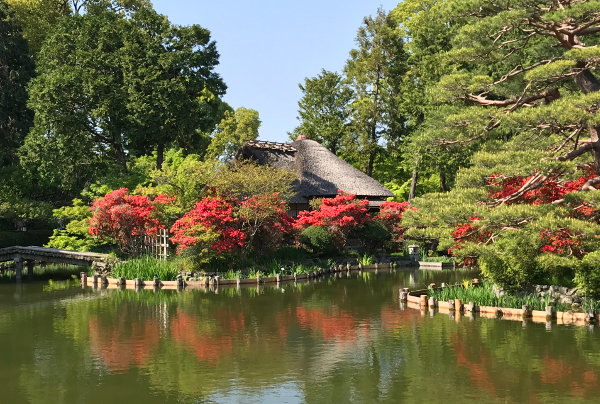 Further along the path, in the north garden, lies Magatama Ike. It has the shape of a comma, resembling the ancient magatama jewels made from jade. Again, it is filled with Iris and lotus flowers, and surrounded by plum and cherry trees. There is no prominent pond in the west garden, but instead, there are many little paths among colourful hydrangea bushes and peaceful trees.
Further along the path, in the north garden, lies Magatama Ike. It has the shape of a comma, resembling the ancient magatama jewels made from jade. Again, it is filled with Iris and lotus flowers, and surrounded by plum and cherry trees. There is no prominent pond in the west garden, but instead, there are many little paths among colourful hydrangea bushes and peaceful trees.
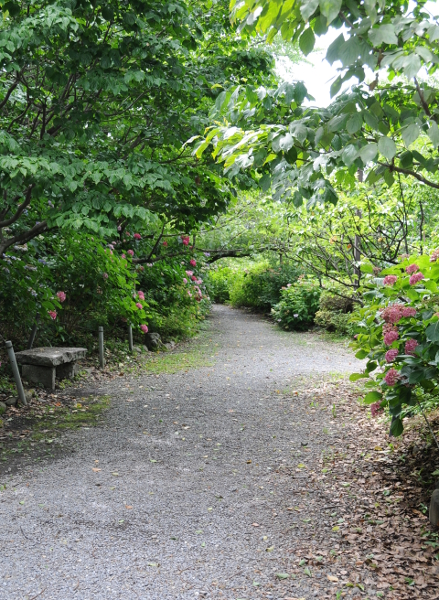 The best time to visit the gardens is in the first half of the year, where different flowers mark the passage of time, starting with plums and cherries, iris and lotus flowers and azaleas and hydrangeas. Spring is especially lovely when the 500 plum trees of 40 varieties in different colors from bright white to dark crimson are in bloom. Although less interesting in summer and autumn, the west garden has many hidden paths with quiet benches, where you can sit in the shade and enjoy the solitude.
The best time to visit the gardens is in the first half of the year, where different flowers mark the passage of time, starting with plums and cherries, iris and lotus flowers and azaleas and hydrangeas. Spring is especially lovely when the 500 plum trees of 40 varieties in different colors from bright white to dark crimson are in bloom. Although less interesting in summer and autumn, the west garden has many hidden paths with quiet benches, where you can sit in the shade and enjoy the solitude.
Umenomiya Taisha is a hidden gem worth visiting for all those who like to venture off the beaten tracks. It should also be on the list for cat lovers since the family of the shrine’s priest is taking care of a large colony of very photogenic cats. They seem to be very popular with even renowned photographers, and there are postcards of the cats for sale at the shrine. Yet more unconventional shrine souvenirs are umeboshi, pickled plums, made from the very plums that grow in the gardens, or a bottle of sake that is specially made for the shrine – although probably not by the gods any more.
Matsunoo Taisha
Matsunoo Taisha – lovingly called Matsuo-san by the locals – marks the western end of Shijo dori with its large torii. Matsunoo Taisha was established in 701 by Hata-no-Imikitori, the head of the local ruling clan. The story goes that he saw a turtle (a sign of luck and longevity) in a waterfall and decided to build a shrine here. However, the locals had worshipped a certain boulder on the mountain for a long time before that already. In any case, Matsunoo Taisha is one of the oldest shrines in Kyoto, and the Hata clan was instrumental in moving the capital to Kyoto eventually.
 The two main gods enshrined at Matsunoo Taisha are O-yamagui-no-kami, the god of brewing sake and of Matsuo-san, the mountain behind the shrine; and Ichiki-shima-hime-no-mikoto, a female deity protecting travellers.
The two main gods enshrined at Matsunoo Taisha are O-yamagui-no-kami, the god of brewing sake and of Matsuo-san, the mountain behind the shrine; and Ichiki-shima-hime-no-mikoto, a female deity protecting travellers.
The main entrance of Matsunoo Taisha is at the large, 14m high torii at the western end of Shijo street. A smaller road leads to the main shrine, where there is another torii. From there, the path leads up some steps to the two-storey Romon gate, which is – like the one at Yasaka shrine across the city – guarded by two zuishin warrior statues to the left and right.
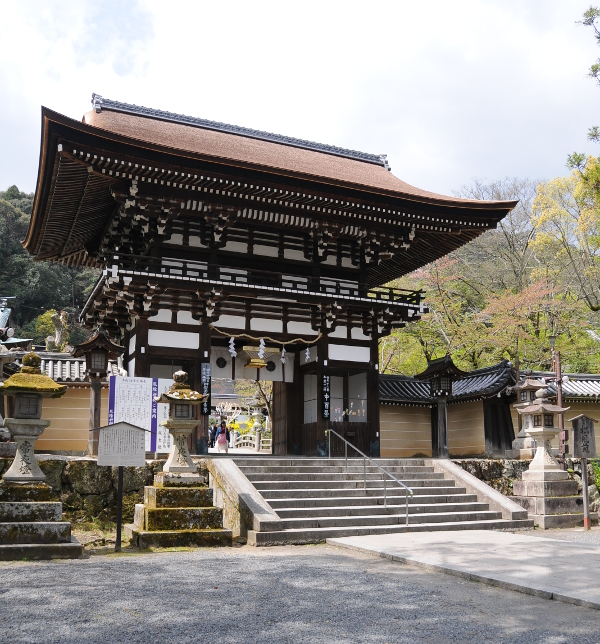 Passing through the gate, at first, there is a small stone bridge to cross, and a few more steps lead directly up to the dance stage. At the left of it is a large display of sake barrels. While these are common donations to shrines, Matsunoo Taisha, as home of the god of sake brewing, has received a large number of barrels originating from sake brewers from all over Japan.
Passing through the gate, at first, there is a small stone bridge to cross, and a few more steps lead directly up to the dance stage. At the left of it is a large display of sake barrels. While these are common donations to shrines, Matsunoo Taisha, as home of the god of sake brewing, has received a large number of barrels originating from sake brewers from all over Japan.
Behind the dance stage lies the long haiden outer hall where people worship and behind that, the impressive honden main hall. This is the oldest building of the shrine, dating back to 1397 and is designated Important Cultural Asset. Its unusual roof – in the so-called Matsuo-zukuri style – forms porticos on the back as well as in the front of the building.
 After praying at the haiden, go to the right and through the low entrance to the back of the shrine where a path leads uphill. To the right, there is the famous Kame-no-i well, where a large black turtle spews holy water. It is said, that this water will bring health and longevity to those who drink it. Even more importantly: If sake is brewed with even a small fraction of this water, it will not go bad. Therefore, many sake brewers visit the shrine regularly to get some of the water, and to pray for business success. Further up the path lies the shrine’s sacred waterfall Reiki-no-taki, which marks the spot where Hata no Imikitori allegedly watched the turtle swim all these years ago.
After praying at the haiden, go to the right and through the low entrance to the back of the shrine where a path leads uphill. To the right, there is the famous Kame-no-i well, where a large black turtle spews holy water. It is said, that this water will bring health and longevity to those who drink it. Even more importantly: If sake is brewed with even a small fraction of this water, it will not go bad. Therefore, many sake brewers visit the shrine regularly to get some of the water, and to pray for business success. Further up the path lies the shrine’s sacred waterfall Reiki-no-taki, which marks the spot where Hata no Imikitori allegedly watched the turtle swim all these years ago.
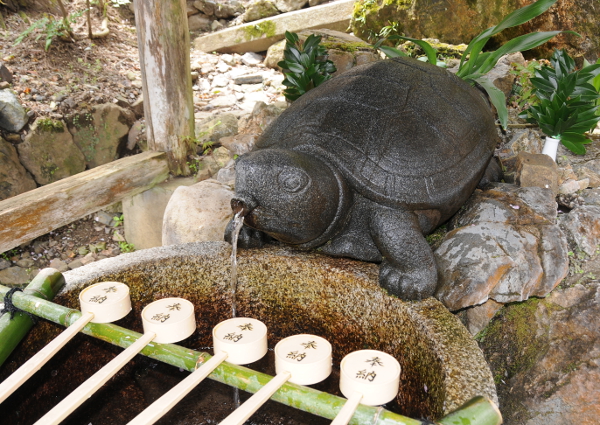 Nearby the Kame-no-i well lies the entrance to two of the three gardens that make up the Shofu-en garden of Matsunoo Taisha. They were designed by the late Mirei Shigemori just before his death in 1975 and are considered the best modern gardens in Japan. Each of the three parts of the garden is representative of a Japanese era, and the opposing ideas of stillness and movement, represented by large blue-green rocks and water, respectively, are the central design elements.
Nearby the Kame-no-i well lies the entrance to two of the three gardens that make up the Shofu-en garden of Matsunoo Taisha. They were designed by the late Mirei Shigemori just before his death in 1975 and are considered the best modern gardens in Japan. Each of the three parts of the garden is representative of a Japanese era, and the opposing ideas of stillness and movement, represented by large blue-green rocks and water, respectively, are the central design elements.
The first garden behind the entrance is the Kyokusui garden, with a stream of water bending seven times around heavy rocks. The stream is framed by smaller stones, giving it the appearance of a dragon, a water creature in Japanese mythology. The Kyokusui represents the gardens popular at the Heian era, the time of the foundation of Kyoto.
 Beyond the Kyokusui lies the Iwakura or Joko garden, where a number of large rocks scattered on a steep slope represent the ancient times, where the gods roamed the mountain tops of Japan. The two largest rocks on top of the slope are meant to represent the main gods of the shrine. Beyond this garden, there is a path further up the mountain where the original place of worship, the iwakura stone, can be visited.
Beyond the Kyokusui lies the Iwakura or Joko garden, where a number of large rocks scattered on a steep slope represent the ancient times, where the gods roamed the mountain tops of Japan. The two largest rocks on top of the slope are meant to represent the main gods of the shrine. Beyond this garden, there is a path further up the mountain where the original place of worship, the iwakura stone, can be visited.
The third garden, the Horai (the entrance is next to the little restaurant outside the Romon gate), is constructed in the Kaiyu style, where a large pond shaped like a crane is the central focal point. The basic idea here is the Chinese concept of paradise, where people do not get old or die. The rocks represent islands in the sea, and the only movements are contributed by the fountain of youth in the back of the garden and the many carp in the pond.
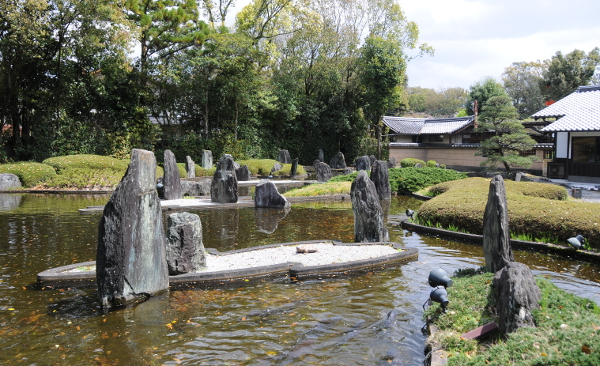 Besides the extensive shrine gardens, which are a rare feature in Shinto shrines, Matsunoo Taisha also has two museums. The treasure hall is the main museum; it is situated between the first two gardens and shows 21 wooden statues in total. The three largest ones date back to the Heian period and are among the oldest and best preserved wood carvings of Japan. Although they are carved in the style of Buddhist statues, two of them are said to show the main Shinto deities of the shrine. These statues with their beautiful serene expressions are among Japan’s national treasures and alone justify a visit to the shrine.
Besides the extensive shrine gardens, which are a rare feature in Shinto shrines, Matsunoo Taisha also has two museums. The treasure hall is the main museum; it is situated between the first two gardens and shows 21 wooden statues in total. The three largest ones date back to the Heian period and are among the oldest and best preserved wood carvings of Japan. Although they are carved in the style of Buddhist statues, two of them are said to show the main Shinto deities of the shrine. These statues with their beautiful serene expressions are among Japan’s national treasures and alone justify a visit to the shrine.
The other museum lies near the entrance, on the way to the parking lot. The little Sake-no-shiryokan shows old tools that were once used to produce sake. They were donated by sake makers worshipping the god of sake brewing here.
 Matsunoo Taisha lies a bit off the beaten tracks of Kyoto’s Arashiyama area, but especially during April and May, when the shrine’s 3000 yellow Kerria bushes are in bloom, it has a distinct charm that should not be missed. The shrine sells a number of unique lucky charms, for example one representing a bright yellow Kerria flower. However, for extra luck, you should try to win your omamori at the game shooting arrows at empty sake barrels.
Matsunoo Taisha lies a bit off the beaten tracks of Kyoto’s Arashiyama area, but especially during April and May, when the shrine’s 3000 yellow Kerria bushes are in bloom, it has a distinct charm that should not be missed. The shrine sells a number of unique lucky charms, for example one representing a bright yellow Kerria flower. However, for extra luck, you should try to win your omamori at the game shooting arrows at empty sake barrels.
Heian Jingu
Heian Jingu is among the newest shrines of Japan. It was built in 1895 as part of the Industrial Exhibition Fair, to commemorate the 1100 year anniversary of the establishment of Kyoto, then known as Heian-kyo. In the beginning, Heian Jingu only enshrined emperor Kanmu, the founder of Kyoto. However, in 1940, emperor Komei was deified and, as the last emperor to reside in Kyoto, was also enshrined here. The shrine is popular with the locals because it was an attempt to halt Kyoto’s decline after the capital had moved to Tokyo – and it did work! So, when it burnt down completely due to arson in 1976, it only took three years to rebuild it. Today, Heian Jingu is considered an Important Cultural Property.
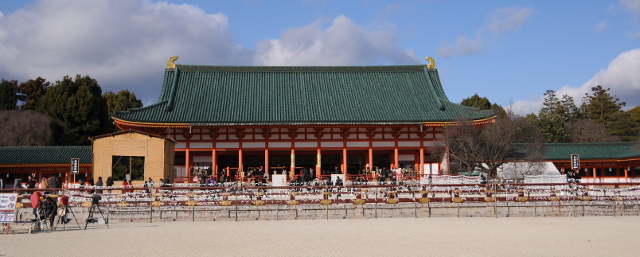 Heian Jingu as a whole is a replica of the ancient imperial palace Daidairi, built at the founding of Kyoto, and destroyed in 1227. The shrine is built in the official compound structure style Chodo-in, on a 5/8-scale of the original. The final designs were made by architectural historian Ito Chuta, and the colorful buildings and vast spaces between them have a distinct Chinese charm, that was very popular during the Heian period. It also gives the shrine a grand and stately atmosphere.
Heian Jingu as a whole is a replica of the ancient imperial palace Daidairi, built at the founding of Kyoto, and destroyed in 1227. The shrine is built in the official compound structure style Chodo-in, on a 5/8-scale of the original. The final designs were made by architectural historian Ito Chuta, and the colorful buildings and vast spaces between them have a distinct Chinese charm, that was very popular during the Heian period. It also gives the shrine a grand and stately atmosphere.
The first building to greet visitors in the impressive, two-storey Otenmon gate in vermillion, green, and white, once the main gate of the old Heian palace. However, the official entrance to the shrine is 500 m further to the south, at the huge torii, one of Kyoto’s landmarks. Interestingly, the torii was erected only in 1929, when, with a hight of 24,4 m and legs that boast a diameter of 3,6 m, it was the largest torii in Japan.
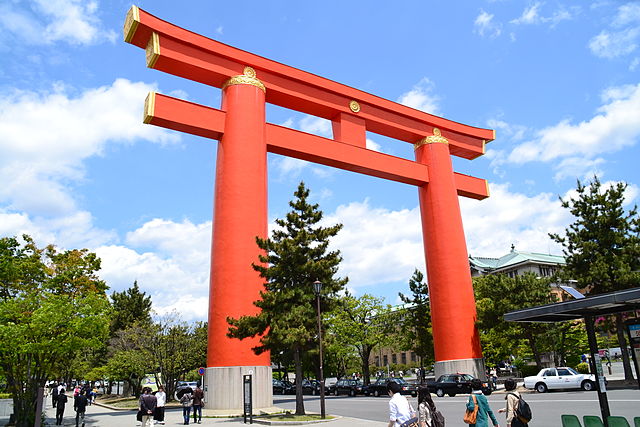 Passing through the Otenmon gate, the shrine opens up into a large courtyard, at the north of which lies the Daigokuden, the Great Hall of State, where once the emperor conducted the state affairs. The Daigokuden is divided into three parts: In the Gaihaiden front shrine, people come to worship and buy good luck charms. Behind it lies the inner sanctuary, which was once used only for imperial ceremonies, but today, shinto ceremonies like weddings or the popular shichi-go-sai shrine visits for kids take place here. At the very back lies the main sanctuary, where the kami are enshrined and only the priests have access.
Passing through the Otenmon gate, the shrine opens up into a large courtyard, at the north of which lies the Daigokuden, the Great Hall of State, where once the emperor conducted the state affairs. The Daigokuden is divided into three parts: In the Gaihaiden front shrine, people come to worship and buy good luck charms. Behind it lies the inner sanctuary, which was once used only for imperial ceremonies, but today, shinto ceremonies like weddings or the popular shichi-go-sai shrine visits for kids take place here. At the very back lies the main sanctuary, where the kami are enshrined and only the priests have access.
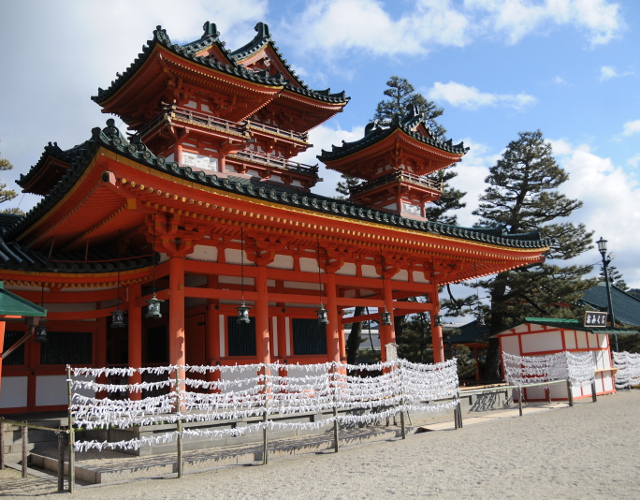 At the eastern and western end of the courtyard lie two towers called Soyru-ro (blue dragon tower) and Byakko-ro (white tiger tower), respectively. Those two animals are guardians of the east and west, and they also adorn two fountains nearby the entrance. Of course, there are also guardians of the north (Genbu, a black snake-turtle) and south (Suzaku, a vermillion bird). Images of the four animals can also be found on the iron lanterns present throughout the shrine.
At the eastern and western end of the courtyard lie two towers called Soyru-ro (blue dragon tower) and Byakko-ro (white tiger tower), respectively. Those two animals are guardians of the east and west, and they also adorn two fountains nearby the entrance. Of course, there are also guardians of the north (Genbu, a black snake-turtle) and south (Suzaku, a vermillion bird). Images of the four animals can also be found on the iron lanterns present throughout the shrine.
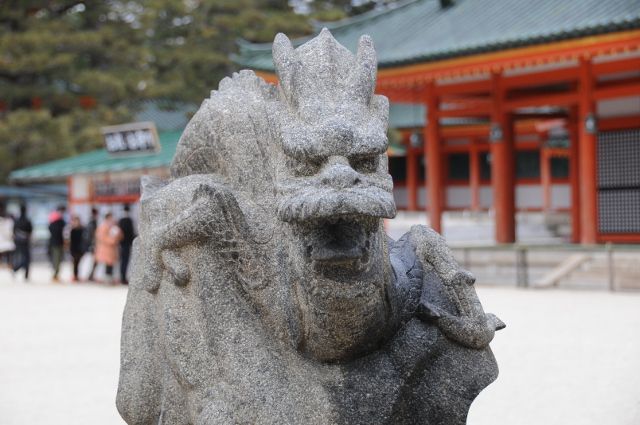 A very interesting feature of Heian Jingu is its large public garden, 33.000 square metres hidden behind the buildings. Construction on the Shinen Garden, which is divided into four parts, started in 1895, but it took 20 years to complete. Today, the entrance is at a gate at the western end of the courtyard, and directly behind it lies the South or Heian Garden, with some 200 species of plants that are mentioned in Heian era literature. It is also the resting place of Japan’s oldest street car that once ran through Kyoto.
A very interesting feature of Heian Jingu is its large public garden, 33.000 square metres hidden behind the buildings. Construction on the Shinen Garden, which is divided into four parts, started in 1895, but it took 20 years to complete. Today, the entrance is at a gate at the western end of the courtyard, and directly behind it lies the South or Heian Garden, with some 200 species of plants that are mentioned in Heian era literature. It is also the resting place of Japan’s oldest street car that once ran through Kyoto.
Further along the path lie the West, Middle, and Eastern Gardens. They were designed by famous Kyoto gardener Ueji VII (aka Jihei Ogawa), whose style is readily recognized. Unusual for a Shinto garden, Shinen is centered around large ponds that draw water from the Lake Biwa Canal, and are home to rare turtles and fish.
 In the West Garden, Byakko-Ike pond shows about 2000 Irises, representing the 200 species that grow in Japan. The Middle Garden follows with Soryu-ike pond that is crossed by stepping-stones called Garyuko. They were once part of old Sanjo and Gojo bridges built in the 16th century. However, the East Garden is the largest one, with Seiho-ike pond at its center, and many weeping cherries all over. The big attraction here is the covered bridge Taiheikaku, a gift from the imperial palace in the 1970s. The ceremonial hall Shobikan, that is reached after crossing the bridge, was also an imperial gift, today it is used for the weddings that take place at the shrine.
In the West Garden, Byakko-Ike pond shows about 2000 Irises, representing the 200 species that grow in Japan. The Middle Garden follows with Soryu-ike pond that is crossed by stepping-stones called Garyuko. They were once part of old Sanjo and Gojo bridges built in the 16th century. However, the East Garden is the largest one, with Seiho-ike pond at its center, and many weeping cherries all over. The big attraction here is the covered bridge Taiheikaku, a gift from the imperial palace in the 1970s. The ceremonial hall Shobikan, that is reached after crossing the bridge, was also an imperial gift, today it is used for the weddings that take place at the shrine.
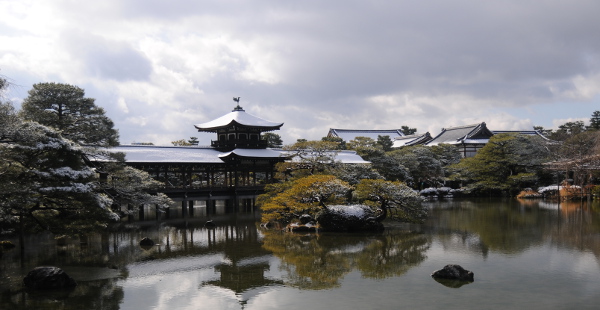 Heian Jingu is popular among tourists and locals alike. The gardens are a must-see in every season (although most famed during cherry blossoms) and the shrine itself is a popular destination for locals for their hatsumode visit or the Adult Day celebrations.
Heian Jingu is popular among tourists and locals alike. The gardens are a must-see in every season (although most famed during cherry blossoms) and the shrine itself is a popular destination for locals for their hatsumode visit or the Adult Day celebrations.
Oyamazaki Sanso
Last Thursday, two friends and I took advantage of the holiday to visit Oyamazaki Sanso, or, officially: The Asahi Beer Oyamazaki Villa Museum of Art. It is located on a hillside in the south-western part of Kyoto, overlooking the place where the rivers Kizu, Uji, and Katsura merge. The villa consists of a number of buildings in a more than 16000 m2 large garden, which alone is worth a visit, in particular now.
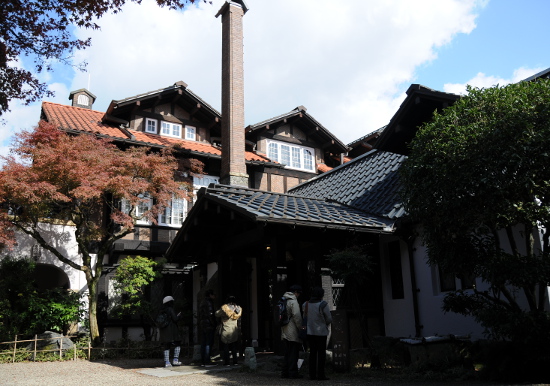 The main house was built in the Taisho era (about 100 years ago) and was subsequently enlarged. It has an obvious Western feeling to it, but even so, there are many features that are reminiscent of Japanese style: enormous wooden beams (one square one with a side length of 50cm) support the ceilings, and the entrance and second floor have high ceilings where the roof structure can be seen, there are little ornaments featuring bamboos… But mainly, the house is Western style: there are two large terraces on the second floor, together with a very modern looking guest bathroom with beige tiles that even features fixtures for hot water. The ground floor sports a large dining room and parlour with enormous fireplace, and out into the back, there is an airy corridor with lots of windows that once led to a greenhouse for orchids.
The main house was built in the Taisho era (about 100 years ago) and was subsequently enlarged. It has an obvious Western feeling to it, but even so, there are many features that are reminiscent of Japanese style: enormous wooden beams (one square one with a side length of 50cm) support the ceilings, and the entrance and second floor have high ceilings where the roof structure can be seen, there are little ornaments featuring bamboos… But mainly, the house is Western style: there are two large terraces on the second floor, together with a very modern looking guest bathroom with beige tiles that even features fixtures for hot water. The ground floor sports a large dining room and parlour with enormous fireplace, and out into the back, there is an airy corridor with lots of windows that once led to a greenhouse for orchids.
 This main house was built as a country villa for Shotaro Kaga, a wealthy businessman from Osaka. He had many interests, like cultivating orchids and drawing pictures of them, and he was also involved in the founding of Nikka Whisky Distilling. A close friend of his was Tamesaburo Yamamoto, the first president of the Asahi Breweries. After the death of Kaga and his wife, the house changed hands a number of times, but eventually fell into disrepair. By the mid 1980s, the house was slated for demolition to make room for luxury apartments, but the locals could convince Asahi Breweries to buy and renovate the Oyamazaki Sanso.
This main house was built as a country villa for Shotaro Kaga, a wealthy businessman from Osaka. He had many interests, like cultivating orchids and drawing pictures of them, and he was also involved in the founding of Nikka Whisky Distilling. A close friend of his was Tamesaburo Yamamoto, the first president of the Asahi Breweries. After the death of Kaga and his wife, the house changed hands a number of times, but eventually fell into disrepair. By the mid 1980s, the house was slated for demolition to make room for luxury apartments, but the locals could convince Asahi Breweries to buy and renovate the Oyamazaki Sanso.
The old buildings were renovated, and two new buildings that now serve as the main museum were added. Designed by Japanese architect Tadao Ando, they are so well integrated into the site that they are all but inconspicuous when approaching the main building. The whole museum now contains the main house, a watchtower (from where Kaga watched the main house being built), two tea houses, a rest house (originally a garage) and the modern jewelry box and dream box museum annexes. The museum opened in 1996, and the old buildings were designated as Registered Tangible Cultural Properties in 2004.
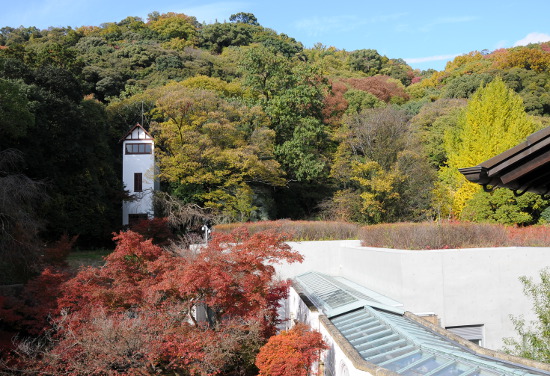 The museum shows various special exhibitions during the year, and it also shows pieces from the Yamamoto collection of art, collected by the first president of Asahi Breweries who was interested in the Mingei Movement that focused on folk art. The underground jewelry box, a small, round single room shows parts of the permanent collection, in particular some of Monet’s Water Lilies paintings. This was quite a surprise to me, mostly because the museum is so small. I now found out that Monet had painted some 250 versions of the Water Lilies, but still, that there are three of those paintings in such a small museum is quite a feat I think.
The museum shows various special exhibitions during the year, and it also shows pieces from the Yamamoto collection of art, collected by the first president of Asahi Breweries who was interested in the Mingei Movement that focused on folk art. The underground jewelry box, a small, round single room shows parts of the permanent collection, in particular some of Monet’s Water Lilies paintings. This was quite a surprise to me, mostly because the museum is so small. I now found out that Monet had painted some 250 versions of the Water Lilies, but still, that there are three of those paintings in such a small museum is quite a feat I think.
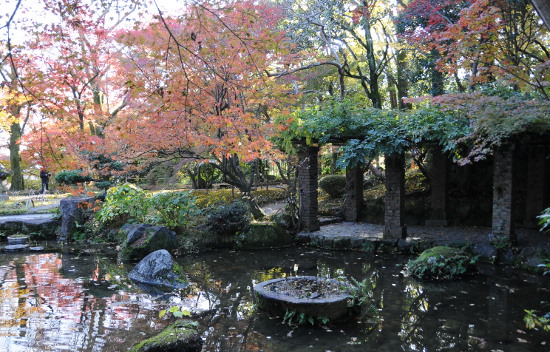 As mentioned above, the museum lies in an enormous garden on a hillside. Especially now during the koyo, the garden is lovely – and it can be visited for free, by the way! Of course there are the obligatory Japanese lanterns and little bridges over the water, and right next to the entrance to the jewely box with the Water Lilies paintings there is – a waterlily pond. The pond with the carp next to the corridor that once led to the greenhouse was my personal favourite spot.
As mentioned above, the museum lies in an enormous garden on a hillside. Especially now during the koyo, the garden is lovely – and it can be visited for free, by the way! Of course there are the obligatory Japanese lanterns and little bridges over the water, and right next to the entrance to the jewely box with the Water Lilies paintings there is – a waterlily pond. The pond with the carp next to the corridor that once led to the greenhouse was my personal favourite spot.
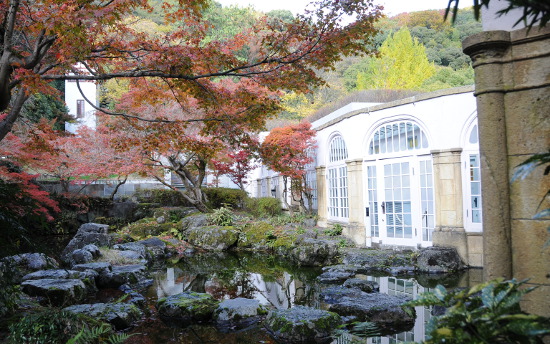 Unfortunately, it was not allowed to take photos inside the building. There are beautiful ones on the homepage of the Asahi Beer Oyamazaki Villa Museum of Art’s homepage though, including a video and lots and lots of information about the building, the collection, the location… Do check it out, it’s worth it:
Unfortunately, it was not allowed to take photos inside the building. There are beautiful ones on the homepage of the Asahi Beer Oyamazaki Villa Museum of Art’s homepage though, including a video and lots and lots of information about the building, the collection, the location… Do check it out, it’s worth it:
http://www.asahibeer-oyamazaki.com/english
Hakusasonso
Kyoto has lots of beautiful Japanese gardens, and there’s only so much time to visit them all. Last week, in the peak of the momiji season, I took time out to visit Hakusasonso, a private garden near Ginkakuji temple. I had passed by there many times before, but now I finally went in.
 The Hakusasonso is the former residence of Kansetsu Hashimoto, a nihonga painter of the Taisho and early Showa period. He bought the site in 1913 when it was nothing more than rice paddies. Until his death in 1945, he worked on the 7400 square metres that make up the gardens now and most of it – including the buildings – are unchanged. Today, the garden is still in possession of the Hashimoto family.
The Hakusasonso is the former residence of Kansetsu Hashimoto, a nihonga painter of the Taisho and early Showa period. He bought the site in 1913 when it was nothing more than rice paddies. Until his death in 1945, he worked on the 7400 square metres that make up the gardens now and most of it – including the buildings – are unchanged. Today, the garden is still in possession of the Hashimoto family.
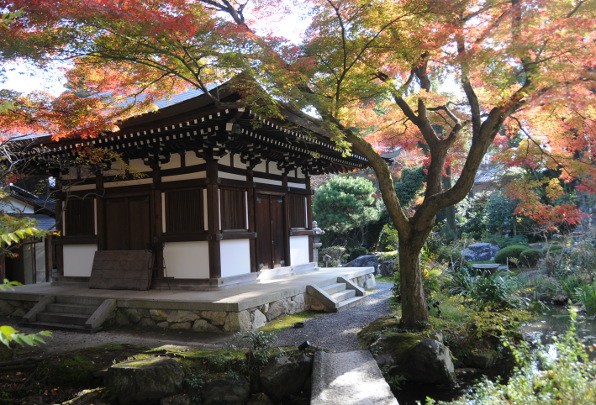 There are five old buildings in the garden, two small tea houses, one private Buddhist temple, and the old residence that is now used as an expensive kaiseki restaurant. The most interesting building is called zonkoro, it is essentially one very large hall that Hashimoto used as his studio. All four walls have large glass windows, and you can see almost all of the garden from the studio.
There are five old buildings in the garden, two small tea houses, one private Buddhist temple, and the old residence that is now used as an expensive kaiseki restaurant. The most interesting building is called zonkoro, it is essentially one very large hall that Hashimoto used as his studio. All four walls have large glass windows, and you can see almost all of the garden from the studio.
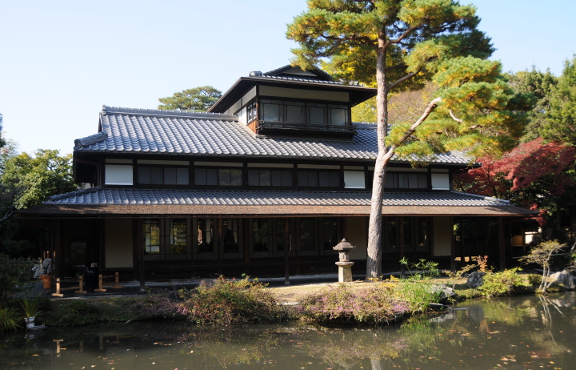 Not only did he paint, Hashimoto also designed the buildings and the garden himself. He collected stone lanterns, pagodas, and Buddha statues (many from China) and placed them throughout the garden. Especially lovely is the little hill where Buddha statues meditate underneath large bamboos.
Not only did he paint, Hashimoto also designed the buildings and the garden himself. He collected stone lanterns, pagodas, and Buddha statues (many from China) and placed them throughout the garden. Especially lovely is the little hill where Buddha statues meditate underneath large bamboos.
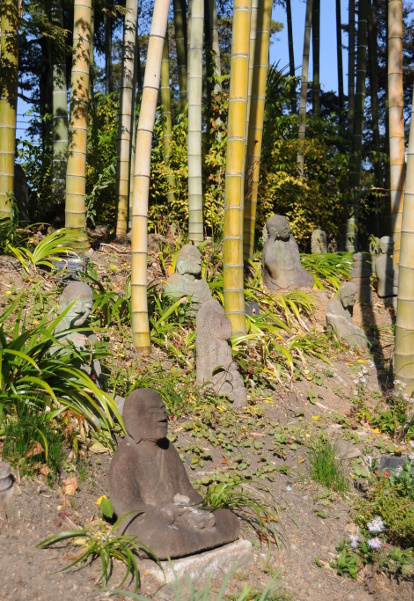 At one end of the garden there is the museum, a modern, two storey building where Hashimoto’s works are displayed. From the second floor of the museum, one can overlook the whole garden, and with the borrowed landscape of Mount Daimonji in the back, the scenery is made perfect. In the late 19th and early 20th century, Nihonga was a special style of painting that combined Western painting methods and ideas with Japanese materials and aesthetics. Nowadays, most Japanese painters work in truly Western style, and the distinction to Nihonga has all but disappeared.
At one end of the garden there is the museum, a modern, two storey building where Hashimoto’s works are displayed. From the second floor of the museum, one can overlook the whole garden, and with the borrowed landscape of Mount Daimonji in the back, the scenery is made perfect. In the late 19th and early 20th century, Nihonga was a special style of painting that combined Western painting methods and ideas with Japanese materials and aesthetics. Nowadays, most Japanese painters work in truly Western style, and the distinction to Nihonga has all but disappeared.

